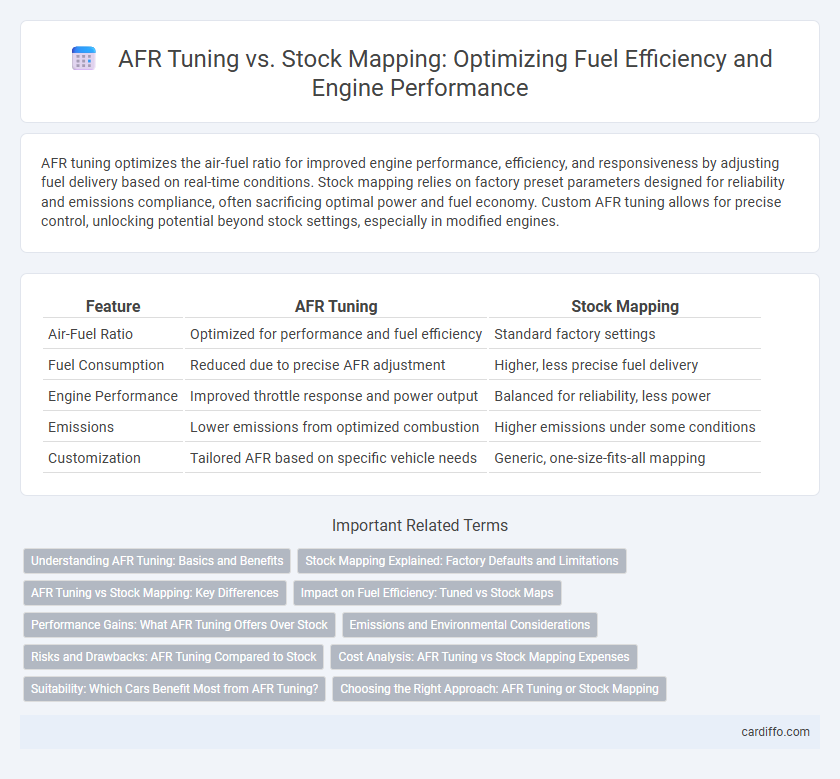AFR tuning optimizes the air-fuel ratio for improved engine performance, efficiency, and responsiveness by adjusting fuel delivery based on real-time conditions. Stock mapping relies on factory preset parameters designed for reliability and emissions compliance, often sacrificing optimal power and fuel economy. Custom AFR tuning allows for precise control, unlocking potential beyond stock settings, especially in modified engines.
Table of Comparison
| Feature | AFR Tuning | Stock Mapping |
|---|---|---|
| Air-Fuel Ratio | Optimized for performance and fuel efficiency | Standard factory settings |
| Fuel Consumption | Reduced due to precise AFR adjustment | Higher, less precise fuel delivery |
| Engine Performance | Improved throttle response and power output | Balanced for reliability, less power |
| Emissions | Lower emissions from optimized combustion | Higher emissions under some conditions |
| Customization | Tailored AFR based on specific vehicle needs | Generic, one-size-fits-all mapping |
Understanding AFR Tuning: Basics and Benefits
Air-Fuel Ratio (AFR) tuning adjusts the precise mixture of air and fuel delivered to an engine, optimizing combustion efficiency and performance beyond standard stock mapping. Unlike stock maps designed for general conditions, AFR tuning customizes fuel delivery to match specific engine modifications, driving habits, and environmental factors, resulting in improved power output and fuel economy. Accurate AFR tuning reduces emissions and engine knock risk by maintaining optimal combustion conditions tailored to a vehicle's unique requirements.
Stock Mapping Explained: Factory Defaults and Limitations
Stock mapping uses factory defaults programmed by the manufacturer to balance fuel efficiency, emissions, and performance for a broad range of conditions, but it often lacks optimization for specific engines or modifications. These default air-fuel ratio (AFR) settings prioritize emissions compliance and drivability over maximum power or fuel economy. AFR tuning customizes the fuel delivery based on real-time data, allowing precise adjustments to improve combustion efficiency and performance beyond the limitations of stock mapping.
AFR Tuning vs Stock Mapping: Key Differences
AFR tuning precisely adjusts the air-fuel ratio for optimal combustion efficiency, enhancing performance and fuel economy compared to stock mapping which uses a generic, mass-production baseline. Stock mapping prioritizes emissions and engine safety, often resulting in conservative AFR settings that limit power output. AFR tuning leverages real-time data and custom calibration to balance power, responsiveness, and fuel consumption, delivering a tailored engine management solution.
Impact on Fuel Efficiency: Tuned vs Stock Maps
AFR tuning optimizes the air-fuel ratio to achieve more complete combustion, directly enhancing fuel efficiency compared to stock mapping that often prioritizes performance or emissions. Stock maps typically run richer mixtures to ensure engine safety and longevity, which can result in higher fuel consumption. By fine-tuning AFR, engines can reduce fuel usage while maintaining power, leading to noticeable improvements in miles per gallon (MPG) and overall fuel economy.
Performance Gains: What AFR Tuning Offers Over Stock
AFR tuning optimizes the air-fuel ratio beyond the conservative limits of stock mapping, unlocking significant performance gains by improving combustion efficiency and power output. Precision adjustments in AFR allow for increased throttle response, better fuel atomization, and reduced engine knocking, resulting in enhanced acceleration and higher horsepower. Unlike stock maps, which prioritize emissions and fuel economy, AFR tuning customizes fuel delivery for specific driving conditions, maximizing engine performance and responsiveness.
Emissions and Environmental Considerations
AFR tuning optimizes the air-fuel ratio for improved combustion efficiency, reducing unburned fuel and lowering harmful emissions such as CO and hydrocarbons compared to stock mapping. Stock mapping often prioritizes engine performance and fuel economy but may result in richer mixtures that increase pollutant output and soot levels. Adjusting AFR to leaner blends within safe limits enhances catalytic converter efficiency, contributing to better environmental compliance and reduced carbon footprint.
Risks and Drawbacks: AFR Tuning Compared to Stock
AFR tuning alters the air-fuel ratio from stock settings, increasing the risk of engine knock, overheating, and accelerated wear if not precisely calibrated. Stock mapping is designed with conservative fuel mixtures to ensure engine reliability, emissions compliance, and warranty protection, minimizing potential damage. Improper AFR tuning can lead to decreased engine longevity and costly repairs, while stock maps prioritize safety and durability over maximum performance.
Cost Analysis: AFR Tuning vs Stock Mapping Expenses
AFR tuning typically incurs higher upfront costs due to specialized equipment and expert calibration required to optimize air-fuel ratios precisely. In contrast, stock mapping expenses are generally lower since the pre-configured settings are factory-installed and do not require additional customization. Long-term fuel efficiency and engine performance gains from AFR tuning may offset initial costs, making it a cost-effective investment compared to standard stock mapping over time.
Suitability: Which Cars Benefit Most from AFR Tuning?
AFR tuning offers significant benefits for high-performance and modified vehicles by optimizing the air-fuel ratio for specific engine demands, unlike stock mapping designed for general driving conditions. Cars with forced induction systems, such as turbocharged or supercharged engines, gain improved throttle response, power output, and fuel efficiency through tailored AFR adjustments. Vehicles equipped with aftermarket exhaust, intake, or engine internals also benefit most from AFR tuning, as it ensures precise combustion and prevents engine knock or lean conditions.
Choosing the Right Approach: AFR Tuning or Stock Mapping
Choosing the right approach between AFR tuning and stock mapping depends on performance goals and engine characteristics. AFR tuning optimizes the air-fuel ratio for improved fuel efficiency and power, while stock mapping provides a baseline calibration designed for general reliability and emissions compliance. Prioritize AFR tuning for custom engine builds or performance upgrades and stock mapping for daily drivability and warranty preservation.
AFR Tuning vs Stock Mapping Infographic

 cardiffo.com
cardiffo.com